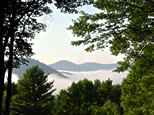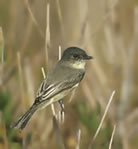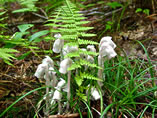
Nature Journal
| |
|
| Saturday, August 30, 2003 | |
 Found
this red-tailed hawk feather in
the woods. This feather is from the inner part of the tail. Found
this red-tailed hawk feather in
the woods. This feather is from the inner part of the tail. Red-tails have a complete molt once a year. The molt begins after the fledglings have left the nest and continues into the fall. Immature red-tailed hawks have a grayish- |
|
until the fall of their second year. |
|
| Thursday, August 28, 2003 | |
| Saw
a "hummingbird moth" the other day. They're a lot of fun
to watch! It was a Slender
Clearwing (Hemaris gracilis). About a week ago, one of my neighbors saw a hummingbird moth that fit the same description. I didn't know this species was found in Vermont. |
|
| Tuesday, August 26, 2003 | |
 Woke
up to this peaceful scene this morning - with the fog looking like
a river of white and the tops of the mountains showing above it. Woke
up to this peaceful scene this morning - with the fog looking like
a river of white and the tops of the mountains showing above it. |
|
| Sunday, August 24, 2003 | |
|
Seems
like the sound of the snowy tree crickets is getting louder every
night. They sound so beautiful! Their rate of their chirping depends
on the temperature; the warmer it is, the faster they chirp. |
|
| Friday, August 22, 2003 | |
 I'm
still hearing the song of the I'm
still hearing the song of the Eastern Phoebe in the mornings and also sometimes in the evenings. While having breakfast, I often see one flycatching from a tree near the house. Phoebes molt during the months of August and September. Some begin their southward migration around the end of September and others wait until |
|
| Wednesday, August 20, 2003 | |
| Saw 5 male turkeys a couple of days ago. I could tell that four of them were fairly young since they had short beards. There was one older turkey with a much longer beard. After breeding season is over, the male turkeys tend to travel and forage in small groups. | |
| Monday, August 18, 2003 | |
 Lately,
I've been seeing a lot of Indian Pipes (Monotropa uniflora).
As the blossoms on this plant ripen, the heads turn upward. And as
the plant ages, its color turns to black. Lately,
I've been seeing a lot of Indian Pipes (Monotropa uniflora).
As the blossoms on this plant ripen, the heads turn upward. And as
the plant ages, its color turns to black.Indian Pipes don't use chlorophyl; instead they receive their |
|
matter. It is believed that these plants have a symbiotic relationship with certain fungi, which break down the nutrients so they are available to the Indian Pipes. And, since these plants don't need chlorophyl, they can grow in very shady spots. |
|
| Top of page | |
|
|
| Birds | Butterflies | Mammals |
| Garden Shop |
New England:
Connecticut, Maine, Massachusetts, New Hampshire, Rhode Island, Vermont